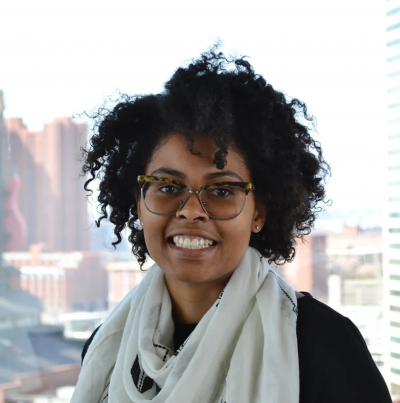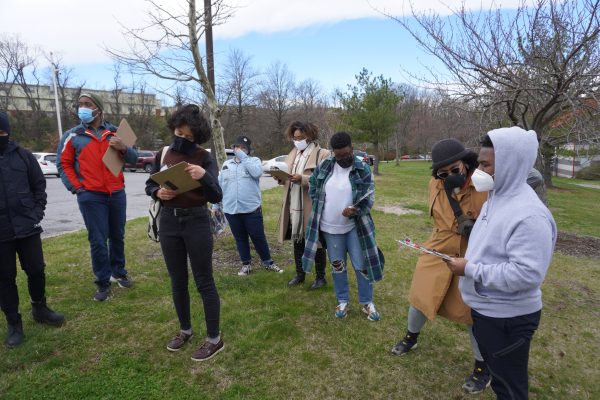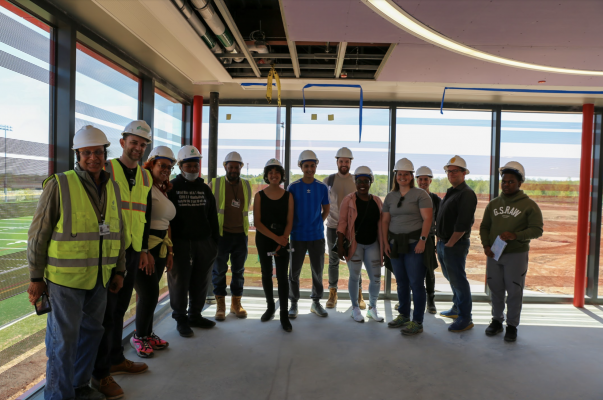An Interview with Courtney Morgan, AICAD Post Graduate Teaching Fellow

Courtney Morgan
Courtney Morgan is a human-centered researcher and designer and an assistant professor at Parsons School of Design. After receiving her MA/MBA from Johns Hopkins University and the Maryland Institute College of Art, Courtney decided she had a vested interest in teaching. In her work, Courtney engages in community development and engagement through the design of public spaces, spatial design, park design, and community housing. She now shares her expertise and experience with the students as a fellow in the Design Strategy department at Parsons. I had the pleasure of interviewing Courtney about her work, experience as an AICAD fellow, and how teaching has influenced her career.
Joanna Booth (AICAD): Hello Courtney! Thank you for taking the time to meet with me this morning. Can you tell me a little bit more about yourself and what brought you to your specific masters program?
Courtney Morgan: I’m actually formally trained as an architect at Morgan State University and studied architecture and environmental design. From there, I started practicing architecture and worked in the profession for a number of years, but like many people during covid, I had a lot of time to reflect and really decided that now would be the time for me to go back to school. I got an email from the program I ended up applying to saying that they had scholarships available and that I didn’t have to take the GMAT or the GRE, and I said THIS IS IT! It is now or never.
I ended up attending the joint Johns Hopkins University and MICA MA/MBA program in design leadership. I decided I wanted to focus on people and communities as opposed to the buildings they lived in, so that’s what drew me to the program. Through the MA/MBA program, I gained the vocabulary to talk about the strategy work that I had been doing for a number of years. I was also able to take electives at MICA. I had been doing a lot of community workshops, and I realized through MICA that I could do a teaching certificate, which I really wanted to do. I ended up pursuing the teaching certificate and being a teaching assistant at Johns Hopkins as well.
JB: What prompted you to apply for the AICAD teaching fellowship?
CM: Through the pedagogy class at MICA, my professor Dr. Pamela Lawton nudged me toward the AICAD fellowship. At first I was unsure because I didn’t think I would have the time, but she kept pushing it! She convinced me that I was already teaching and had 10 years of experience in the workforce, so I put some materials together and applied. That was Fall of 2021, and in the Spring of 2022 I heard back from Parsons! I went through the interview process and they eventually asked if I wanted the job. I said “Absolutely, I will move my family now!” When Parsons is interested, you follow it through (laughing). When I first arrived, I met with some of the other professors that I would be teaching with and they were so welcoming! I just wasn’t expecting that. I really felt like, “is this a dream?”. My department is so supportive and I have many other supportive women in my corner as well, which I think was imperative for integrating and my success here. This is the best job I’ve ever had, and I’ve had a lot of jobs!

Courtney Leading Project: Reimagine Middle Branch : Community Design Lab
in Baltimore, MD
JB: Tell us about your daily routine as a fellow, what classes are you teaching and how do you engage with your students?
CM: Last semester I taught in the Design Strategy Graduate Program, which was an evening class. I had a small class of eight. It was such a small class that they started to use the classroom space to build community. They even ate dinner together at 6 and we started class at 7. We would then move to ice breakers, and because this class was a seminar, we did discussions and then we would do design activities. I would have to set timers for the class because they wouldn’t stop talking! They were really engaged. It also felt that I was teaching amongst peers, who had a similar level of experience and were making similar decisions that I was just two years prior by making the decision to move into design strategy. I was able to share my experiences with how strategy has been working so far for me.
For undergrad, I taught a studio course called Integrated Design, which I’m teaching again this semester. I focus on building community first, especially in a city like New York. I think it’s important that students feel connected to each other and me. Studio is really independently lead, and I give the students prompts, themes, and some deliverables, and they show up and blow my mind every time.
JB: How has it been adjusting to a different academic environment at Parsons? How has your experience differed from your time at MICA or Johns Hopkins?
CM: I would say I didn’t realize how southern I was until I got to New York! I typically don’t think about Baltimore as southern, but one of the biggest differences I found was that New York is such a busy and diverse place.
I think it’s really important to ground my students in the classroom for them to produce the way I expect them to. I spend thirty minutes out of my three hour class getting to know my students. In order to bear your soul and ask the questions you need to be asked, you need to be able to trust me as an educator.
My flexibility in my teaching has changed as well. At Parsons, there is an elevated level of stress and anxiety, so I remind my students to not over stress about a presentation or project delivery, we’re working through this together. At the end of the day, it’s about whether or not you feel like this work is important, so I’ve been working to demystify this prestige surrounding Parsons and that art school has to be this toxic space.

Courtney Leading Project: Reimagine Middle Branch : Community Design Lab
in Baltimore, MD
JB: How has teaching and experience with your students influenced your art practice? (If it has at all)
CM: I think it has, because we have folks coming from all different mediums and perspectives. It’s been really interesting to see different types of work but even different levels of production and curiosity. I had a conversation with my students about how they’re representing their work and about comparison, and not having to compare ourselves to each other and it’s more about the conversations to be had. I took a step back and reflected on that in my own practice. Sometimes, when I present myself and offer my services, it can come off as whimsical, and I think whimsy can be perceived as insecurity. I had to realize when collaborating it’s important to know when to be directive, so teaching has been helpful in understanding my communication style. I also think that the simple fact that my students are so engaged, it’s boosted my confidence as well, especially in my practice as a design strategist.
You can find out more about Courtney and her work with The Studio for Collaboration, Research and Design Here